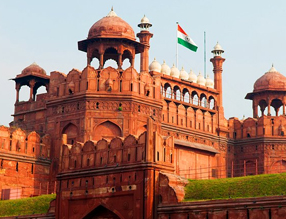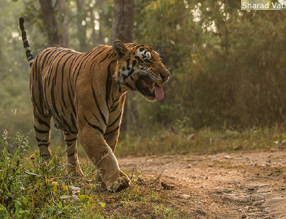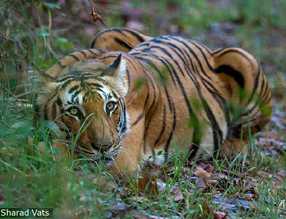Duration: 15 Nights / 16 Days
Place to visit: New Delhi – Nagpur – Pench – Kanha – Bandhavgarh – Khajuraho – Varanasi – Agra - New Delhi- fly back
 Day 01: Arrive New Delhi (by flight)
Day 01: Arrive New Delhi (by flight)
Meet and greet on arrival at New Delhi airport by our representative. He will transfer you to the Hotel, assist you in check in at the hotel, handover and explain all the travel related documents. Overnight stay at the Hotel.
Day 02: New Delhi - Nagpur - Pench (100 kms/2 hrs drive + flight)
Early breakfast, and transfer to the airport in the morning to board a flight at 0645 hour to arrive Nagpur at 0830hrs. Met at the airport and drive to Pench National Park 100 kms / 2-hour drive. On arrival check into the Resort. After lunch go for afternoon jeep drive to the national park.
Dinner and overnight stay at the resort.
Day 03: In Pench
Morning and afternoon Jeep safari to the National park. Meals and overnight at the resort.
A total of 758 Sq. kms of this Southern Indian tropical moist deciduous forest has its extent mingling with the tropical dry deciduous teak. The area is crisscrossed by a number of streams and 'nallahs' most of which are seasonal. Though the Pench River dries up in April end, a number of water pools locally known as 'dohs' are found which serve as water holes for the wild animals. The Pench Reservoir at the center of the park is the only major water source during the pinch period.
As a prey concentration is high along the Pench River, tiger usually inhabits and frequents this belt. Leopards though generally operate in the peripheral areas but are occasionally seen in the deep forest also. Jungle cats are commonly seen. Leopard cats, small Indian civets and palm civets are seen rarely.
In Pench, Cheetal, Sambar, are commonly seen grazing on the open sites on roadsides and banks of river & reservoir. Jackals can be seen in search of food anywhere in the Park. Packs of upto 15 or more wild dog can be seen near Chhedia, Jamtara, Bodanala and Pyorthadi areas of the Reserve. Herds of gaur can be spotted near streams and bamboo patches commonly in summer months. Sloth beer occupy the rocky areas and favour mahul bel infested forest. Chinkara is present in very small numbers and is found in open areas around Turia, Telia and Dudhgaon villages. Dinner and overnight stay at Pench.
Day 04: Pench – Kanha (210 kms /4-5 hrs drive)
Morning jeep safari to the national park and after lunch drive to Kanha national park 210 kms/ 4-5 hour drive. On arrival check into the Resort. Dinner and overnight at the resort in Kanha.
Day 05: In Kanha
 Wake up at 0500hrs, tea coffee with biscuits, and proceed for the morning safari to the National park.
Wake up at 0500hrs, tea coffee with biscuits, and proceed for the morning safari to the National park.
Kanha's sal and bamboo forests, rolling grasslands and meandering streams stretch over 940 sq km in dramatic natural splendor which form the core of the Kanha Tiger Reserve created in 1974 under Project Tiger. The park is the only habitat of the rare hardground Barasingha (Cervus Duvaceli Branderi).
This is the original Kipling country of which he wrote so vividly in his Jungle Book. Packed breakfast which comes from the Lodge is served at a designated spot and spread on the bonnet of the Safari vehicle. Enjoy your breakfast in the wilderness of Kanha.
Continue your search for the elusive Tiger if you have not yet seen the same, and soak in the fresh, and energizing environment. Return from Safari around 1130hrs. Freshen up, and Lunch is served.
Depart for afternoon jeep safari Kanha National Park. Return at 6pm from safari. Dinner and overnight at the Lodge. Dinner and overnight at the Lodge.
Day 06: In Kanha
Wake up, and get ready for another day of adventure in the National park. The forests of the Banjar valley and Halon valley, respectively forming Kanha's western and eastern halves. By a special statute in 1955, Kanha National Park came into being. Since then, a string of stringent conservation programmes have been launched, for the overall protection of the park's fauna and flora. Kanha boasts of about 38 species of mammals. Some of the inhabitants of this park are the gaur, the largest of the world's cattle; the sambar, the largest Indian deer; and the chausingha, the only four-horned antelope in the world. Other frequent visitors include the Nilgai antelope, the sloth bear, the dhole, or Indian wild dog, and an occasional Leopard. Some 300 species of birds inhabit the park, that includes the storks, egrets, black ibis, raptors, owls, and the red-wattled lapwings.
Depart for afternoon jeep safari Kanha National Park. Return at 6pm from safari. Dinner and overnight at the Lodge.
Day 07: Kanha – Bandhavgarh (by surface 280 kms/6 hrs drive)
Morning safaris to the national park and depart for Bandhavgarh, 280kms, 6 hour drive. Carry packed lunch. On arrival check into the Lodge. Lunch, Dinner and overnight at the Lodge.
Day 08: In Bandhavgarh
Breakfast, Lunch and Dinner at the Resort. Morning and afternoon safaris in the park
Bandhavgarh: The national park is mainly known for the density of its tiger population. This is the place where famous White Tigers of Rewa were discovered. The other wild attractions in the park include Leopards, Blue Bulls, Indian Gaur (Bison) Chausingha (Four Horned Antelopes), Spotted Deers, Sambar Deer, Wild Boar, Sloth Bears Fox, Jackals, Wild Dogs, etc. There are at least 22 mammal species and about 250 bird species in the Park. The other animals found in Bandhavgarh are Ratel, Porcupine, Small Indian Civet, Palm Squirrel, Lesser Bandicoot rat, the Jungle Cat, and the shy Hyenas. The reptile population in the park includes Cobras, Kraits, Vipers, Ratsnakes, Pythons, Monitor Lizards and turtles. The two-primate species - the rhesus macaque and the Hanuman langur - inhabit Bandhavgarh. Dinner and overnight at the Resort
Day 09: In Bandhavgarh
 Breakfast, Lunch and Dinner at the Resort. Morning and afternoon safaris in the park
Breakfast, Lunch and Dinner at the Resort. Morning and afternoon safaris in the park
Bandhavgarh has been a center of human activity and settlement for over 2000 years, and there are references to it in the ancient books, the Narad-Panch Ratra and the Shiva Purana.
The oldest sign of habitation in the park are caves dug into the sandstone to the north of the fort. Several contain Brahmi inscriptions dating from the 1st century B.C. Various dynasties have ruled the fort, for example, the Maghas from the 1st century A.D., the Vakatakas from the 3rd century A.D., From that time onwards Bandhavgarh was ruled by a succession of dynasties including the Chandela Kings Bandhavgarh became more and more deserted until forest overran the area band it became the royal hunting reserve. This helped to preserve the forest and its wildlife, although the Maharajas made full use of their rights. At independence Bandhavgarh remained the private property of the Maharaja until he gave it to the state for the formation of the National Park in 1968. After the park was created poaching and hunting was brought under control and the number of animals rose dramatically. The Tigers in particular prospered and the 1986 extension provided much needed forest to accommodate them. Overnight at the resort.
Day 10: In Bandhavgarh
Breakfast, Lunch and Dinner at the Resort. Morning and afternoon safaris in the park Overnight at the resort.
Day 11: Bandhavgarh- Khajuraho (by road 280 kms/6 hrs drive)
Morning jeep safari to the national park and after breakfast drive to Khajuraho 280 kms/6 hrs drive. On arrival check into the hotel. Later city tour of Khajuraho.
Khajuraho, discovered by chance, is India’s second biggest single tourist attraction. Khajuraho has the largest group of medieval temples that are adorned with numerous sculptures of extraordinary grace and delicacy celebrating the stylized and refined courtly accomplishments of beauty, love and creative arts. Once the religious capital of the Chandela Rajputs, the temples of the city date from 950-1050 AD. A wall with eight gates encloses the entire area and two golden palm trees flank each of them. Originally, there were over 80 temples, of which only 22 are now remarkably preserved.
The set of temples at Khajuraho celebrating Hindu religious thought in its mystifying variety of scope and inclusion stands distinguished from rest of the Hindu temples. The temples highlight the existential ethos in religion that venerates ‘Yoga’ and ‘Bhoga’. ‘Yoga’ is union of the self with the Almighty, while ‘Bhoga’ is the path to God through physical pleasure.
The temples at Khajuraho, dedicated to physical love and pleasure are a testimony to this philosophy. Declared a World Heritage Site in 1986, Khajuraho is a prominent, must-see destination and its temples are India’s unique gift to the world as they capture life in every form and mood in stone. Evening Sound and Light show at Khajuraho. Overnight at the hotel in Khajuraho.
Day 12: Khajuraho – Varanasi (by flight)
After breakfast visit the Eastern and Southern group of temples. The Parasvanath temple of the Eastern group is the group's largest Jain temple. The themes depict, in charming detail, everyday activity. Also visit the Kandariya Mahadev temple dedicated to Shiva and the Chaturbhuj temple of the Southern group.
Afternoon transfer to the airport to board the flight for Varanasi. Leave Khajuraho for Varanasi by AI 405 (1515 / 1610 hrs ) Meeting and assistance on arrival at Varanasi airport and transfer to the hotel.
Varanasi is one of India’s most important pilgrimage sites and the holiest of holy cities for Hindus. Known also as Kashi and Benaras, Varanasi is one of the world’s oldest living cities, and has been a centre of learning and culture for well over 2000 years.
Evening : Visit the “Ghats” or bank of the Ganga River. This is a fascinating walk as you can experience the cultural ethos that guides the life of the pious. See the rituals that take place to the setting sum and the ablutions that are performed in the river. As boats float down-stream, some carrying goods, fruits and vegetables, you will see others carrying the pious who perform
ceremonies along the river.
On the banks or “ghats”, you can see some absorbed in prayer and the chanting of hymns, and others engaged in commerce and yet others performing functions like hair-cutting, massaging and even cleaning ears! Walk across to the Manikarnika Ghat, where you can see cremation, performed with intense ritual - the process of sending the departed soul to the heavens. Hindus believe that the gateway to the Heavens and for the Re-incarnation of the Soul `in a better state’, is possible when life’s last journey is from Varanasi. Overnight in Varanasi.
Day 13: Varanasi
Early morning take a boat ride at dawn down India's most sacred river, The Ganges. Sun rise at the holy river is a truly tranquil and breath taking sight with pilgrims standing waist-deep in water, praying to the rising Sun. See the famous Vishwanath temple with its spires covered with gold, dedicated to Shiva, the presiding deity of the city. Return to the hotel for Breakfast
Also visit Sarnath a city located 13 kilometres north-east of Varanasi near the confluence of the Ganges and the Gomati rivers in Uttar Pradesh, India. The deer park in Sarnath is where Gautama Buddha first taught the Dharma, and where the Buddhist Sangha came into existence through the enlightenment of Kondanna. Singhpur, a village approximately one km away from the site, was the birthplace of Shreyansanath, the eleventh Tirthankara of Jainism, and a temple dedicated to him.
Day 14: Varanasi – Agra (by flight )
 After relaxed breakfast transfer to Varanasi airport to board a flight to Agra at 12010 hrs to arrive Agra at 1320 hrs. Met at airport and transfer to hotel. On arrival check into hotel.
After relaxed breakfast transfer to Varanasi airport to board a flight to Agra at 12010 hrs to arrive Agra at 1320 hrs. Met at airport and transfer to hotel. On arrival check into hotel.
Later proceed to visit the red sandstone AGRA FORT which stands like a crescent on the banks of Yamuna River enclosed by forbidding 20-meter high walls, with a 12- meter moat between them. Three successive Mughal emperors - Akbar, Jehangir and Shah Jehan - helped create this massive structure which contains Hindu and Muslim architecture.
Overnight stay at the hotel in Agra
Day 15: Agra – New Delhi (by road, 220kms, 4 hours drive)
Sunrise proceed to visit the famous white marble mausoleum, The Taj Mahal, which was built in the middle of the 17th century by the Moghul emperor Shah Jehan for his wife Mumtaz Mahal.
Completed in 1652, skilled craftsmen from Persia, Turkey, France and Italy and some 20,000 labourers worked for 17 years to build this edifice. [The Taj is closed on Friday].
Return to hotel and after relaxed breakfast Check out from the hotel and drive to New Delhi Overnight stay at the hotel
Day 16: New Delhi Fly back home
After breakfast transfer to International airport to board flight back home or onward destinations
End of our services
Note: The driving hours given above from one city to another are based on the normal conditions of the roads and may vary. Any break for Food / Tea / Toilets / Sightseeing on the way will take extra time than the above given hours.
